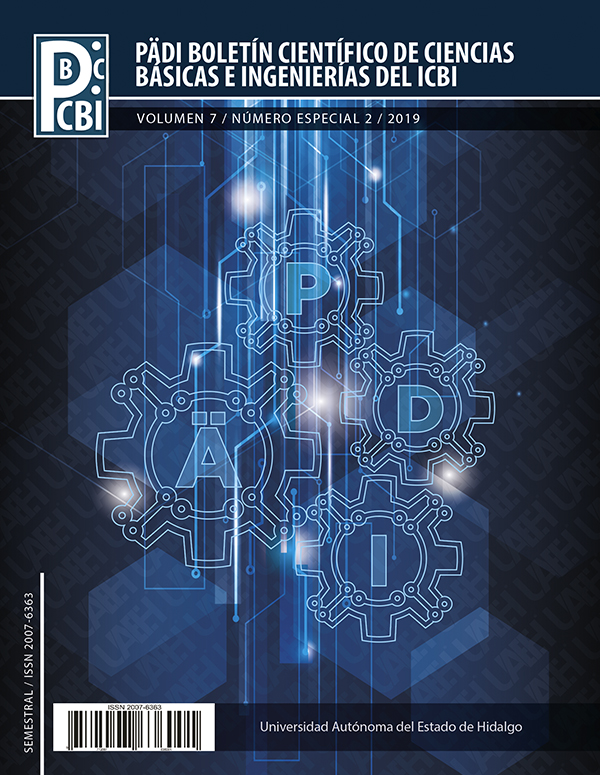Propiedades multiferroicas del compósito bifásico 0.8BaTiO3-0.2CoFe2O4 obtenido mediante mecanosíntesis asistida.
DOI:
https://doi.org/10.29057/icbi.v7iEspecial-2.4707Palabras clave:
multiferroico bifásico, ferrita de cobalto, titanato de bario, ferromagnético, ferroeléctricoResumen
Los materiales multiferroicos presentan simultáneamente ordenamiento ferroeléctrico y ferromagnético, lo cual hace que sean de gran interés tecnológico. Sin embargo, sólo se conoce un material monofásico con características multiferroicas a temperatura ambiente, la ferrita de bismuto (BiFeO3). Una alternativa a materiales monofásicos, es el desarrollo de materiales multiferroicos bifásicos, con una fase ferromagnética y otra ferroeléctrica. En el presente trabajo se reporta la caracterización multiferroica (magnética y dieléctrica) del compósito 0.8BaTiO3-0.2CoFe2O4, obtenido mediante molienda de alta energía asistida con tratamiento térmico. Se mezclaron proporciones adecuadas de BaTiO3 con CoFe2O4 mediante molienda de alta energía, empleando un molino SPEX 8000D durante dos minutos, con una relación bolas-polvo de 60:1 y atmósfera oxidante (aire). La mezcla se compactó uniaxialmente a 800 MPa y posteriormente, se llevó a cabo un proceso de sinterización a 1300 ˚C durante 2 h. Los resultados de DRX confirman la presencia de ambas fases puras, BaTiO3 y CoFe2O4, sin evidencia de interacción química entre ellas. La caracterización dieléctrica muestra un comportamiento típico de un material ferroeléctrico con una permitividad relativa de 45 a 1 MHz. El análisis mediante magnetometría de muestra vibrante muestra un comportamiento ferrimagnético, propio de la ferrita de cobalto, con la particularidad de que exhibe una magnetización menor (11.5 emu/g), debido a la proporción de ferrita presente en el compósito. Los resultados dieléctricos y magnéticos demuestran el carácter multiferroico del compósito.
Descargas
Información de Publicación
Perfiles de revisores N/D
Declaraciones del autor
Indexado en
- Sociedad académica
- N/D
Citas
Grigalaitis, R., Vijatović Petrović, M. M., Bobić, J. D., Dzunuzovic, A., Sobiestianskas, R., Brilingas, A., Banys, J. (2014). Dielectric and magnetic properties of BaTiO3 –NiFe2O4 multiferroic composites. Ceramics International, 40 (4) 6165–6170. https://doi.org/10.1016/j.ceramint.2013.11.069.
Hill, N. A., & Filippetti, A. (2002). Why are there any magnetic ferroelectrics? Journal of Magnetism and Magnetic Materials, 242–245 (PART II), 976–979. https://doi.org/10.1016/S0304-8853(01)01078-2
Jonscher, A. K. (1981). Review A new understanding of the dielectric relaxation of solids. Journal of Materials Science, 16, 2037–2060.
Karaki, T., Yan, K., Miyamoto, T., & Adachi, M. (2007). Lead-free piezoelectric ceramics with large dielectric and piezoelectric constants manufactured from BaTiO3 nano-powder. Japanese Journal of Applied Physics, Part 2: Letters, 46 (4–7), 97–99. https://doi.org/10.1143/JJAP.46.L97
Khaja Mohaideen, K., & Joy, P. A. (2013). Influence of initial particle size on the magnetostriction of sintered cobalt ferrite derived from nanocrystalline powders. Journal of Magnetism and Magnetic Materials, 346, 96–102. https://doi.org/10.1016/j.jmmm.2013.07.016
Khaja Mohaideen, K., & Joy, P. A. (2014). High magnetostriction parameters for low-temperature sintered cobalt ferrite obtained by two-stage sintering. Journal of Magnetism and Magnetic Materials, 371, 121–129. https://doi.org/10.1016/j.jmmm.2014.07.013
Li, J. F., Wang, K., Zhang, B. P., & Zhang, L. M. (2006). Ferroelectric and piezoelectric properties of fine-grained Na 0.5K 0.5NbO 3 lead-free piezoelectric ceramics prepared by spark plasma sintering. Journal of the American Ceramic Society, 89 (2), 706–709. https://doi.org/10.1111/j.1551-2916.2005.00743.x
Lopatin, S., Lopatina, I., & Lisnevskaya, I. (1994). Magnetoelectric PZT/ferrite composite materials. Ferroelectrics, 162 (1), 63–68. https://doi.org/10.1080/00150199408245091
Mohaideen, K. K., & Joy, P. A. (2012). Enhancement in the magnetostriction of sintered cobalt ferrite by making self-composites from nanocrystalline and bulk powders. ACS Applied Materials and Interfaces, 4(12), 6421–6425. https://doi.org/10.1021/am302053q
Pedro-García, F., Sánchez-De Jesús, F., Cortés-Escobedo, C. A., Barba-Pingarrón, A., & Bolarín-Miró, A. M. (2017). Mechanically assisted synthesis of multiferroic BiFeO3 : Effect of synthesis parameters. Journal of Alloys and Compounds, 711, 77–84. https://doi.org/10.1016/j.jallcom.2017.03.292
Ryu, J., Carazo, a. V., Uchino, K., & Kim, H. E. (2001). Piezoelectric and magnetoelectric properties of lead zirconate titanate/Ni-ferrite particulate composites. Journal of Electroceramics, 7, 17–24. https://doi.org/10.1023/A:1012210609895
Schileo, G., Pascual-Gonzalez, C., Alguero, M., Reaney, I. M., Postolache, P., Mitoseriu, L., Feteira, A. (2016). Yttrium Iron Garnet/Barium Titanate Multiferroic Composites. Journal of the American Ceramic Society, 99(5), 1609–1614. https://doi.org/10.1111/jace.14131
Shrout, T. R., & Zhang, S. J. (2007). Lead-free piezoelectric ceramics: Alternatives for PZT. Journal of Electroceramics, 19(1), 111–124. https://doi.org/10.1007/s10832-007-9047-0
Van Den Boomgaard, J., Van Run, A. M. J. G., & Van Suchtelen, J. (1976). Magnetoelectricity in Piezoelectric—Magnetostrictive Composites. Ferroelectrics, 10(1), 295–298. https://doi.org/10.1080/00150197608241997
Van Run, A. M. J. G., Terrell, D. R., & Scholing, J. H. (1974). Grown Eutectic Magnetoelectric Composite Material. Journal of Materials Science, 9(10), 1710–1714.
van Suchtelen, J. (1972). Product properties: A new application of composite materials. Philips Research Report, 27, 28–37.
Yang, H., Zhang, G., Lin, Y., Ye, T., & Kang, P. (2015). Electrical, magnetic and magnetoelectric properties of BaTiO3/BiY2Fe5O12 particulate composites. Ceramics International, 41(5), 7227–7232. https://doi.org/10.1016/j.ceramint.2015.01.139
Zhao, S., Li, G., Ding, A., Wang, T., & Yin, Q. (2006). Ferroelectric and piezoelectric properties of (Na, K)0.5Bi0.5TiO3 lead free ceramics. Journal of Physics D: Applied Physics, 39(10), 2277–2281. https://doi.org/10.1088/0022-3727/39/10/042




















